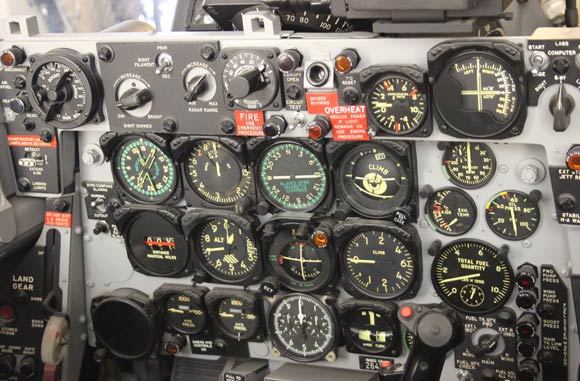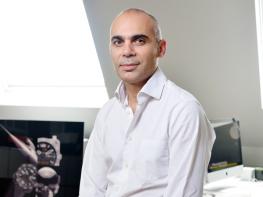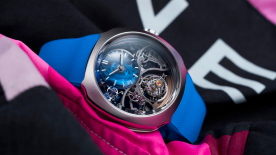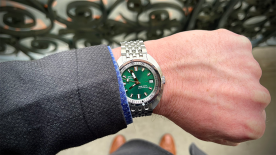How did you start your career as a designer?
I grew up in a small provincial town, far from luxury and design, but close to a certain simplicity. I went to Paris for my high school studies. My subsequent years as a medical student were the toughest and taught me the most, including by challenging my preconceived ideas about myself. I enrolled at the Ecole Nationale de Création Industrielle (French national school for advanced studies in design), the first French school of its kind. I had no artistic background, but I had creative potential which was as yet untapped.
When did you come into contact with watchmaking?
During my course, I did an internship in Hong Kong which was then the Mecca of watchmaking distribution. Upon my return, I contacted Helmut Sinn, owner of the eponymous brand, to do an internship. My degree thesis was based on the creation of a watch brand’s corporate identity. That was the beginning of Bell&Ross.
How was the brand created?
I had known Carlos Rosillo (Ed. note: CEO of the brand) since high school, and together we created “Bell&Ross by Sinn”. Under this name, we resold models that I had designed, based on a different business model. Sinn was very cheap then because it handled sales directly. Our start-up capital was 250,000 French francs at the time. We worked from Carlos’s home and we did everything ourselves. I made my point-of-sale material, Carlos managed the bookkeeping, and we did our own deliveries. We were a start-up.
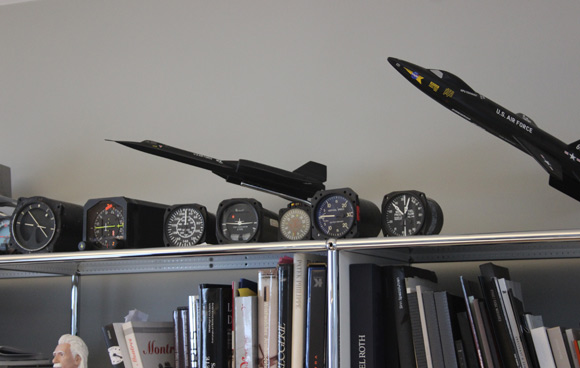
So how did it take off?
There was an article in Heure Internationale which talked about us and the Parisian retailers we had contacted. In 1995, we had our first Basel fair with a little stand near the toilets. We took 2 million francs worth of orders and we were even distributed in Guam. The following year, we experienced our first development crisis. We couldn’t keep up, the banks didn’t want to lend us money and neither were we able to obtain any form of risk capital. At that point we were put in touch with the Chanel group.
At what level did they get involved?
Chanel Suisse, which centralises the group’s watchmaking activities, asked us to renegotiate our contract with Sinn, and to shift from being a reseller to being a client. And they took shares in Bell&Ross. In 1997, we launched the first Vintage collection which was made by Châtelain (Ed. note: the watchmaking decoration and assembly manufacturer for the Chanel group) whereas our partnership with Sinn was coming to an end. Mr Sinn had sold by that time and we were experiencing a growing conflict of interest with the new management.
You launched a watch brand a few years before the incredible growth that this market has experienced. Did you see it coming?
It wasn’t intentional. It was the desire, and the opportunities and meetings that presented themselves. We had our positioning and our identity. Today, with the market overcrowded, it would be more difficult.
“It’s a luxury to make watches the way we do.”
What are Bell&Ross’s key assets?
Product design and visual communication. I am the artistic director and we have our own in-house studio. So everything goes through me, even the packaging and the technical spec sheets. We have never used an advertising agency. That means that everything is coherent and we are in control of our image.
Bell&Ross products are closely linked with the world of aviation. How did this inspiration come about?
Aviation is a dream – and a technological innovation model. And it also is the perfect example of analogue instrumentation.
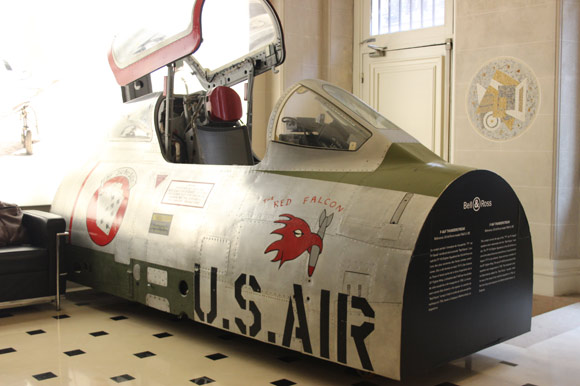
What are Bell&Ross’s key assets?
Product design and visual communication. I am the artistic director and we have our own in-house studio. So everything goes through me, even the packaging and the technical spec sheets. We have never used an advertising agency. That means that everything is coherent and we are in control of our image.
Bell&Ross products are closely linked with the world of aviation. How did this inspiration come about?
Aviation is a dream – and a technological innovation model. And it also is the perfect example of analogue instrumentation.
What is your design philosophy?
I am in the business to please and not to push consumption. And I loathe obsolescence. A good design ages well and engenders just as much pleasure with the passing of time.
How do you work?
I am never bored because there is always something to look at and understand. I have learnt a lot from graphic design because it is a language to which everyone is sensitive. And in particular, typography is really important – it’s a world in its own right. I wasn’t surprised to learn that somebody as obsessive as Steve Jacobs was fascinated by typography.
What typefaces do you use at Bell&Ross?
We use two typefaces. The first is Franklin which is used for road signs in the United States. The second is DIN (Deutsches Institut für Normung), the institute that develops standards in Germany. They are both very utilitarian and very readable. What more could you want for utilitarian watches?
And the large Arabic numerals on your dials which are a key part of your identity?
Those are Adonis. Recently for the Heritage lines we redesigned them to make them rounded. Having said that, our identity is very much about a round shape in a square: the BR01 launched in 2005 represented a major step forward in our development.

How do you feel about your relationship with the army to which Bell&Ross is very close, although it is not always a very pleasant environment …
In a modern country, a modern army is not always about death and insanity. All the officers I talk to are people who have values to which I subscribe. They have a tendency to elevate men and society.
You work with movements which offer a relatively small range of layout possibilities for hands and counters. Doesn’t this constrain you somewhat in your capacity as a designer?
I have never been hindered by the movement positioning. I am quite comfortable with the standards of the ETA movements. We were amongst the first to re-launch two-counter chronographs and I love chronographs with the minutes counter at the centre.
And yet you are amongst the few brands which has always worked with jumping hours and a regulator-type display.
These are simple complications that are super graphic. Jumping hours is a traditional display with a modern effect – something like digital ahead of its time. And the regulator-type display is interesting for a brand like ours because it highlights the minutes and that is what you read first …
Do you particularly enjoy working on higher end projects such as the B-Rocket?
We take the care required with all products but these are showcases, free spaces. It is more satisfying to make a tourbillon or our X1 (Ed. note: a future release…) because you can go into far more detail. But when we made the BR-01 Radar with its display on three discs, we made a simple, remarkable product.
Can you say a few words about the X1?
In our timeline, there is the WW, the Vintage BR and the BR-01. The X1 is the standardisation of the Bell&Ross high-end sports watch. You have to work on sophistication in order to move up a notch …
